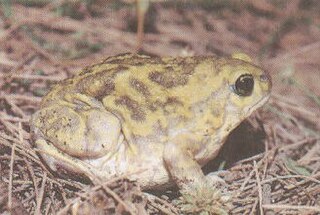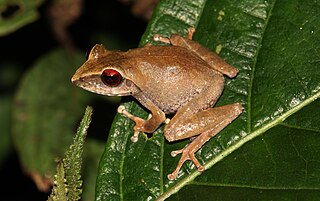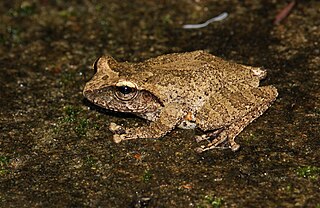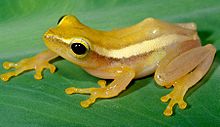
The Rhacophoridae are a family of frogs that occur in tropical sub-Saharan Africa, South India and Sri Lanka, Japan, northeastern India to eastern China and Taiwan, south through the Philippines and Greater Sundas, and Sulawesi. They are commonly known as shrub frogs, or more ambiguously as "moss frogs" or "bush frogs". Some Rhacophoridae are called "tree frogs". Among the most spectacular members of this family are numerous "flying frogs".

The Rhacophorinae are a subfamily of frogs in the family Rhacophoridae. They range from tropical Africa and Asia to temperate China and Japan.

Philautus is a genus of shrub frogs in the family Rhacophoridae from Asia. Some species in this genus are now considered extinct by IUCN, while others are widespread and abundant. The taxonomy of the group is unclear, with many poorly described species.

Adenomus is a small genus of true toads, with only two species, endemic to Sri Lanka. Adenomus kandianus was considered as extinct for 133 years, but was rediscovered in October 2009 in the Kandy area.

Uperodon is a genus of microhylid frogs. They occur in South Asia and Myanmar. Uperodon reached its current composition in 2016 when the genus Ramanella was brought into its synonymy. The common names of these frogs are globular frogs and balloon frogs in reference to their stout appearance, or dot frogs, the last specifically referring to the former Ramanella.
Uperodon nagaoi, also known as the Nagao's pug-snout frog or Nagao's globular frog, is a species of frogs in the family Microhylidae. It is endemic to Sri Lanka and is known from the Central, Sabaragamuwa, Southern, and Western Provinces. The specific name nagaoi honours Eijiro Nagao, president of Marusan Securities who, through the Nagao Environmental Foundation, has supported research on Sri Lankan amphibians.

Pseudophilautus alto is a species of frogs in the family Rhacophoridae. It is endemic to the Central Highlands of Sri Lanka and known from the Horton Plains and Pattipola.
Pseudophilautus extirpo, known as blunt-snouted shrub frog, is an extinct species of frog in the family Rhacophoridae. It was endemic to Sri Lanka. It is only known from the holotype collected in 1882. The specific name extirpo is Latin meaning "destroy" or "eradicate" and refers to the apparent extinction of this species.
Pseudophilautus halyi, known as pattipola shrub frog, is an extinct species of frog in the family Rhacophoridae. It was endemic to Sri Lanka. It is only known from the holotype collected in 1899. The specific name halyi honours Amyrald Haly, the first director of the Ceylon Museum, author of the "Natural History of Ceylon", and the collector of the holotype.

Pseudophilautus schmarda is a species of frog in the family Rhacophoridae. It is endemic to the central hills of Sri Lanka and is known from the Peak Wilderness Sanctuary, Agra Bopath, Horton Plains, and Pedro. The specific name schmarda honours Ludwig Karl Schmarda, an Austrian physician, naturalist, and traveler. Common names Sri Lanka bug-eyed frog and Schmarda's shrub frog have been coined for it.

Pseudophilautus silus, known as pug-nosed shrub frog is a species of frogs in the family Rhacophoridae. It is endemic to southern Sri Lanka and known from the both sides of the Horton Plains.

Pseudophilautus variabilis, also known as the variable bush frog or variable bubble-nest frog, is a species of frog in the family Rhacophoridae. This now extinct species was endemic to Sri Lanka. Despite extensive searches in recent times, it is only known from collections prior to 1858. The reasons for its disappearance are unknown but probably involve habitat loss.

Pseudophilautus viridis, or the dull-green shrub frog, is a species of frogs in the family Rhacophoridae. It is endemic to Sri Lanka and occurs in the central hills of south-central Sri Lanka.
Pseudophilautus zal, commonly known as the white blotched shrub frog, is an extinct species of frog in the family Rhacophoridae. It was endemic to Sri Lanka. It is only known from the type series consisting of three old museum specimens.
Pseudophilautus zimmeri is an extinct species of frog in the family Rhacophoridae. It was endemic to Sri Lanka, where it was recorded from the vicinity of Galle. It is only known from the holotype that was used to describe the species in 1927. The specific name zimmeri honours Carl Wilhelm Erich Zimmer, a German zoologist. Common name Rumassala shrub frog has been coined for it.
Pseudophilautus pardus is an extinct species of Sri Lankan shrub frogs in the family Rhacophoridae. Despite extensive surveys in recent years, the species is known only from a collection made prior to 1858. The reason for its extinction is unknown but probably relates loss of forests.

Pseudophilautus is a genus of shrub frogs in the family Rhacophoridae endemic to the Western Ghats of southwestern India and to Sri Lanka where the majority of the species are found. Many of them are already extinct. On the other, some species believed to be extinct have also been rediscovered.

Taruga is a genus of frogs endemic to Sri Lanka. They are the only foam-nesting tree frogs in the Old World Tree frog family, Rhacophoridae.

Rohan David Pethiyagoda is a Sri Lankan biodiversity scientist, amphibian and freshwater-fish taxonomist, author, conservationist and public-policy advocate.
Pseudophilautus simba is a species of frogs in the family Rhacophoridae endemic to Sri Lanka. It is only known from its type locality in the Morningside Forest Reserve, adjacent to the Sinharaja Forest Reserve, near Rakwana, southern Sri Lanka.













